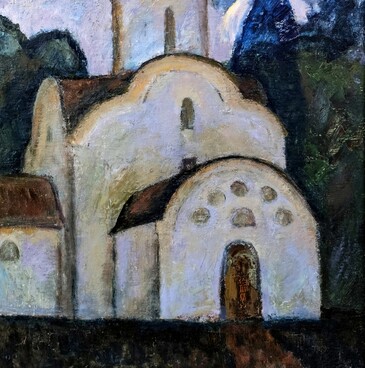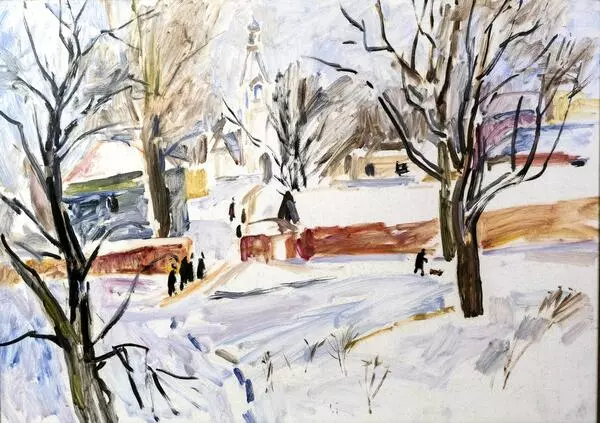The date of foundation of the Assumption Church in Kolmovo has long remained unclear.
Even before the 14th century, there were two monasteries on both banks of the Volkhov River: the Kolmovo one on the left bank and the Kolometsky one on the right.
Some historians and scribes who compiled reports on the service of the clergy attributed the church to the Kolometsky Monastery, and mentioned that it was founded in 1310. However, this monastery ceased to exist by the 14th century.
Valentin Lavrentievich Yanin attributed the church to the Kolmovo Monastery (commissioned by a wealthy person), and explains the connection with the Kolometsky one by a mistake of the copyist-chronicler who combined consonant toponyms.
It is believed that the founder of the Kolmovo monastery was a Novgorod posadnik (1391–1417), boyar Yury Ontsiforovich. According to the Novgorod Fourth Chronicle of 1392, it was then that he “built the wooden church of the Assumption of the Holy Theotokos on Kolmovo, and established a monastery.” In 1423, under his son Mikhail, a stone church replaced the wooden one.
The involvement of the Ontsiforovich family in the monastery’s construction is proved by the spiritual will of Yury’s great-granddaughter Orina (the 15th century), discovered by Vadim Ivanovich Koretsky.
In the 15th century, the Kolmovo Monastery owned the Vodskaya, Shelonskaya and Obonezhskaya pyatinas (administrative divisions); in 1627, Tsar Michael of Russia confirmed its property rights in a charter, and in 1644, Tsar Alexis partially reduced its lands. The monastery received a new charter in 1685, but a year later it became impoverished and was assigned to the Archbishop’s House of St. Sophia.
Archbishop of Novgorod, Makarii did a lot for the Assumption Church since 1526: a monastic charter was introduced under him, the church was renovated (1527) and re-consecrated (1528).
After the Swedish occupation, in 1615, only the Assumption Church was listed in the monastery: the cells and walls were destroyed, and the bells were taken to the cannon yard to be recast.
Metropolitan Job (since 1698), who was a close associate of Peter I, patronized the monastery and lived in it for a long time. Under him, the monastery ensemble was improved. In 1706, an orphanage for children who lost their parents and “foundlings” (illegitimate children) and a “hospital” were opened. The monastery had its own farm, which included an apiary, fish ponds and a dairy farm.
In 1764, the Assumption Church became a parish, and in 1824 it was abolished.
Under Peter III, an asylum for the mentally ill and a temporary shelter for prisoners were located on the territory of the monastery, while under Catherine II — a hospital, a workhouse and a correctional institution.
In 1915, the Kolmovo Monastery housed an infirmary for mentally ill soldiers. Father Vladimir Dukhovskoy took great care of them. For his efforts, he was presented to the Order of Anna, 3rd class.
Even before the 14th century, there were two monasteries on both banks of the Volkhov River: the Kolmovo one on the left bank and the Kolometsky one on the right.
Some historians and scribes who compiled reports on the service of the clergy attributed the church to the Kolometsky Monastery, and mentioned that it was founded in 1310. However, this monastery ceased to exist by the 14th century.
Valentin Lavrentievich Yanin attributed the church to the Kolmovo Monastery (commissioned by a wealthy person), and explains the connection with the Kolometsky one by a mistake of the copyist-chronicler who combined consonant toponyms.
It is believed that the founder of the Kolmovo monastery was a Novgorod posadnik (1391–1417), boyar Yury Ontsiforovich. According to the Novgorod Fourth Chronicle of 1392, it was then that he “built the wooden church of the Assumption of the Holy Theotokos on Kolmovo, and established a monastery.” In 1423, under his son Mikhail, a stone church replaced the wooden one.
The involvement of the Ontsiforovich family in the monastery’s construction is proved by the spiritual will of Yury’s great-granddaughter Orina (the 15th century), discovered by Vadim Ivanovich Koretsky.
In the 15th century, the Kolmovo Monastery owned the Vodskaya, Shelonskaya and Obonezhskaya pyatinas (administrative divisions); in 1627, Tsar Michael of Russia confirmed its property rights in a charter, and in 1644, Tsar Alexis partially reduced its lands. The monastery received a new charter in 1685, but a year later it became impoverished and was assigned to the Archbishop’s House of St. Sophia.
Archbishop of Novgorod, Makarii did a lot for the Assumption Church since 1526: a monastic charter was introduced under him, the church was renovated (1527) and re-consecrated (1528).
After the Swedish occupation, in 1615, only the Assumption Church was listed in the monastery: the cells and walls were destroyed, and the bells were taken to the cannon yard to be recast.
Metropolitan Job (since 1698), who was a close associate of Peter I, patronized the monastery and lived in it for a long time. Under him, the monastery ensemble was improved. In 1706, an orphanage for children who lost their parents and “foundlings” (illegitimate children) and a “hospital” were opened. The monastery had its own farm, which included an apiary, fish ponds and a dairy farm.
In 1764, the Assumption Church became a parish, and in 1824 it was abolished.
Under Peter III, an asylum for the mentally ill and a temporary shelter for prisoners were located on the territory of the monastery, while under Catherine II — a hospital, a workhouse and a correctional institution.
In 1915, the Kolmovo Monastery housed an infirmary for mentally ill soldiers. Father Vladimir Dukhovskoy took great care of them. For his efforts, he was presented to the Order of Anna, 3rd class.





